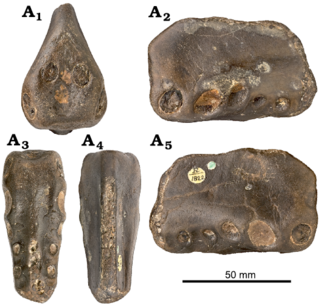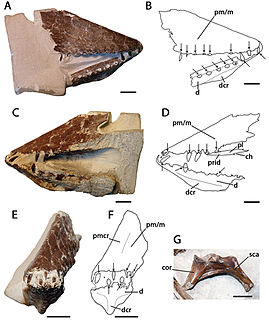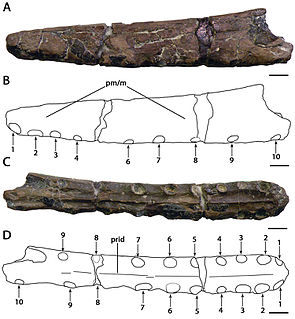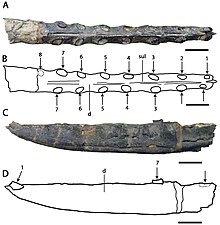
Caulkicephalus is a genus of anhanguerid pterosaur from the Isle of Wight off the coast of England. It lived during the Early Cretaceous period, about 130 million years ago.

Ornithocheirus is a pterosaur genus known from fragmentary fossil remains uncovered from sediments in the UK and possibly Morocco.

Coloborhynchus is a genus of pterodactyloid pterosaur belonging to the family Anhangueridae, though it has also been recovered as a member of the Ornithocheiridae in some studies. Coloborhynchus is known from the Lower Cretaceous of England, and depending on which species are included, possibly the Albian and Cenomanian ages as well. Coloborhynchus was once thought to be the largest known toothed pterosaur, however, a specimen of the closely related Tropeognathus is now thought to have had a larger wingspan.

Lonchodectidae or Lonchodraconidae is a group of pterosaurs within the clade Pterodactyloidea. It has variously been considered to be within Ctenochasmatoidea, Azhdarchoidea and Pteranodontia. They are notable for their high, conical tooth sockets and raised alveolar margins.

Ornithocheiridae is a group of pterosaurs within the suborder Pterodactyloidea. These pterosaurs were among the last to possess teeth. Members that belong to this group lived from the Early to Late Cretaceous periods, around 140 to 90 million years ago.

Uktenadactylus is a genus of anhanguerid pterodactyloid pterosaurs from the Lower Cretaceous Paw Paw Formation of Texas, United States and the Wessex Formation on the Isle of Wight, England. Fossil remains of Uktenadactylus dated back to the Early Cretaceous period, from about 125 to 100 million years ago.
Aetodactylus is a genus of targaryendraconian pterosaur. It is known from a lower jaw discovered in Upper Cretaceous rocks of northeastern Texas, United States.

Anhangueridae is a group of pterosaurs within the suborder Pterodactyloidea. They were among the last pterosaurs to possess teeth. A recent study discussing the group considered the Anhangueridae to be typified by a premaxillary crest and a lateral expansion in the distal rostrum. The same study presented a cladistic analysis, for which an "agreement subtree" was calculated. The Anhangueridae was found to be sister taxon to the large crested Tropeognathus.
Aussiedraco is a genus of targaryendraconian pterodactyloid pterosaur from the early Cretaceous of Australia.
Barbosania is an extinct genus of crestless targaryendraconian pterosaur from the Cretaceous Romualdo Formation of the Santana Group of northeastern Brazil, dating to the Aptian to Albian.

Boreopteridae is a group of pterodactyloid pterosaurs from the Aptian-age Lower Cretaceous Yixian Formation of Liaoning, China.

Ornithocheirae is an extinct clade of pteranodontoid pterosaurs from the Early Cretaceous to the Late Cretaceous of Asia, Europe, North America and South America. It was named by Harry Seeley in 1870 as a family that contains Ornithocheirus and its relatives. The name was emended to Ornithocheiridae, to match the requirements of the ICZN Code that a family-ranked clade should end with an -idae suffix. Brian Andres (2010) in his review of pterosaur phylogeny, defined the name Ornithocheirae phylogenetically, as a node-based taxon consisting of the last common ancestor of Anhanguera and Ornithocheirus and all its descendants. Thus Ornithocheirae is defined to include two families, the Anhangueridae and the Ornithocheiridae, following the opinion of Alexander Kellner and Andres that these families should not be synonymized based on their original phylogenetical definitions. However, subsequent studies in 2019 have found Ornithocheirae to be a more inclusive group containing both Anhangueria and Targaryendraconia.

Cimoliopterus is a genus of pterosaur that lived during the Late Cretaceous in what is now England and the United States. The first known specimen, consisting of the front part of a snout including part of a crest, was discovered in the Grey Chalk Subgroup of Kent, England, and described as the new species Pterodactylus cuvieri in 1851. The specific name cuvieri honours the palaeontologist George Cuvier, whereas the genus Pterodactylus was then used for many pterosaur species that are not thought to be closely related today. It was one of the first pterosaurs to be depicted as models in Crystal Palace Park in the 1850s. The species was subsequently assigned to various other genera, including Ornithocheirus and Anhanguera. In 2013, the species was moved to a new genus, as Cimoliopterus cuvieri; the generic name Cimoliopterus is derived from the Greek words for "chalk" and "wing". Other specimens and species have also been assigned to or synonymised with the species with various levels of certainty. In 2015, a snout discovered in the Britton Formation of Texas, US, was named as a new species in the genus, C. dunni; the specific name honours its collector, Brent Dunn.

Lonchodraco is a genus of lonchodraconid pterodactyloid pterosaur from the Late Cretaceous of southern England. The genus includes species that were previously assigned to other genera.

Camposipterus is a genus of pterodactyloid pterosaur from the Early Cretaceous of England. Fossil remains of Camposipterus dated back to the Early Cretaceous, about 112 million years ago.

Anhangueria is a group of pterosaurs belonging to the clade Pteranodontoidea. Fossil remains of this group date back from the Early to Late Cretaceous periods, around 140 to 92.5 million years ago. Anhangueria was named by paleontologists Taissa Rodrigues and Alexander Kellner in a review of Ornithocheirus species in 2013, they defined the clade as a branch-based taxon consisting of all pteranodontoids more closely related to Anhanguera blittersdorffi than to Istiodactylus latidens and Cimoliopterus cuvieri.

Ornithocheiromorpha is a group of pterosaurs within the suborder Pterodactyloidea. Fossil remains of this group date back from the Early to Late Cretaceous periods, around 140 to 92.5 million years ago. Ornithocheiromorphs were discovered worldwide except Antarctica, though most genera were recovered in Europe, Asia and South America. They were the most diverse and successful pterosaurs during the Early Cretaceous, but throughout the Late Cretaceous they were replaced by better adapted and more advanced pterosaur species such the pteranodontids and azhdarchoids. The Ornithocheiromorpha was defined in 2014 by Andres and colleagues, and they made Ornithocheiromorpha the most inclusive clade containing Ornithocheirus, but not Pteranodon.

Iberodactylus is a genus of pterodactyloid pterosaurs belonging to the clade Anhangueria, that during the Early Cretaceous lived in the area of present Spain. The type species is Iberodactylus andreui.

Targaryendraco is a genus of pterodactyloid pterosaur from the Early Cretaceous period of Hannover, northern Germany. Fossil remains of Targaryendraco dated back about 132 million years ago.

Hamipteridae is a small family of anhanguerian pterosaurs known from the Early Cretaceous of China and Spain.





























